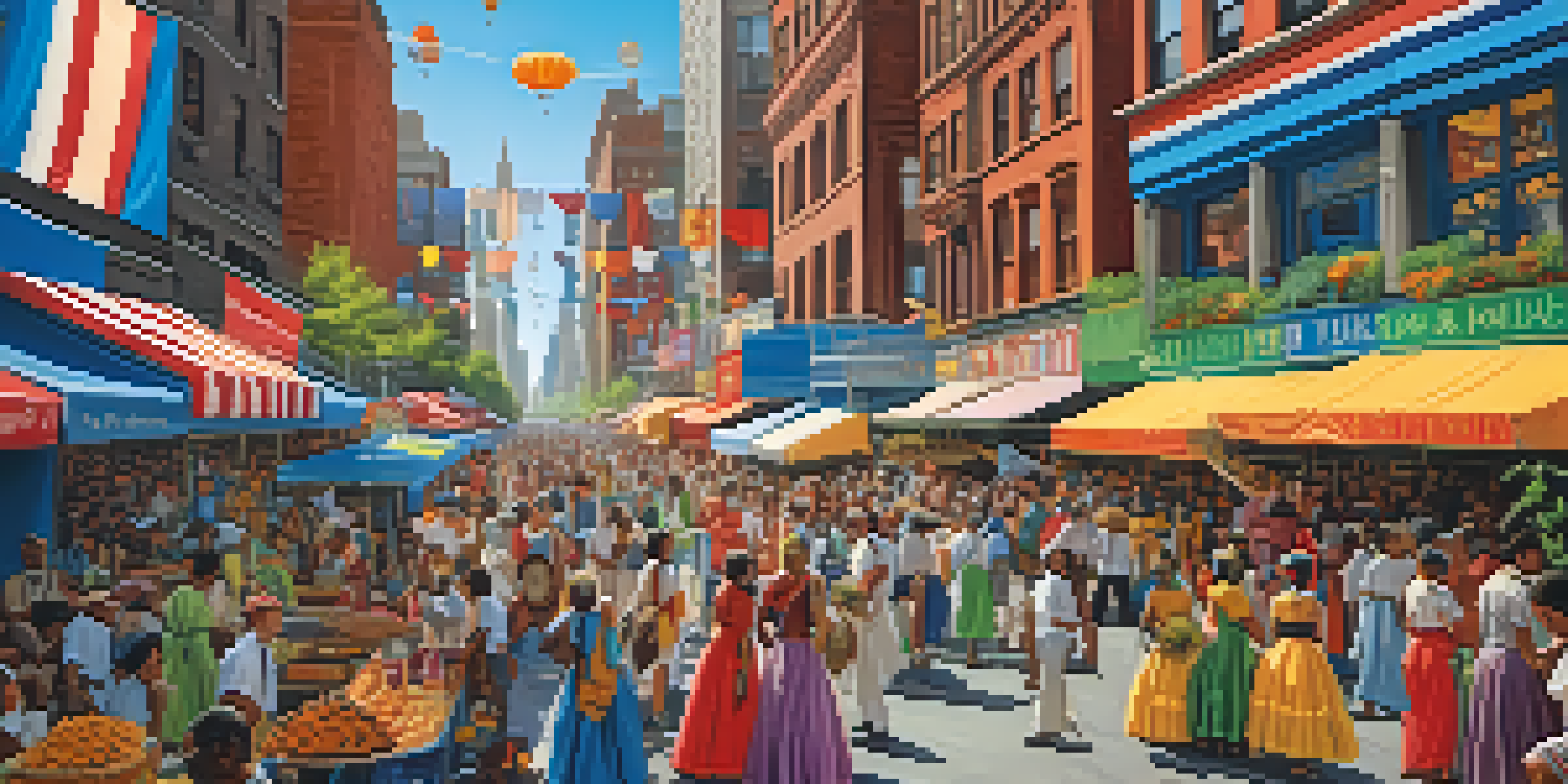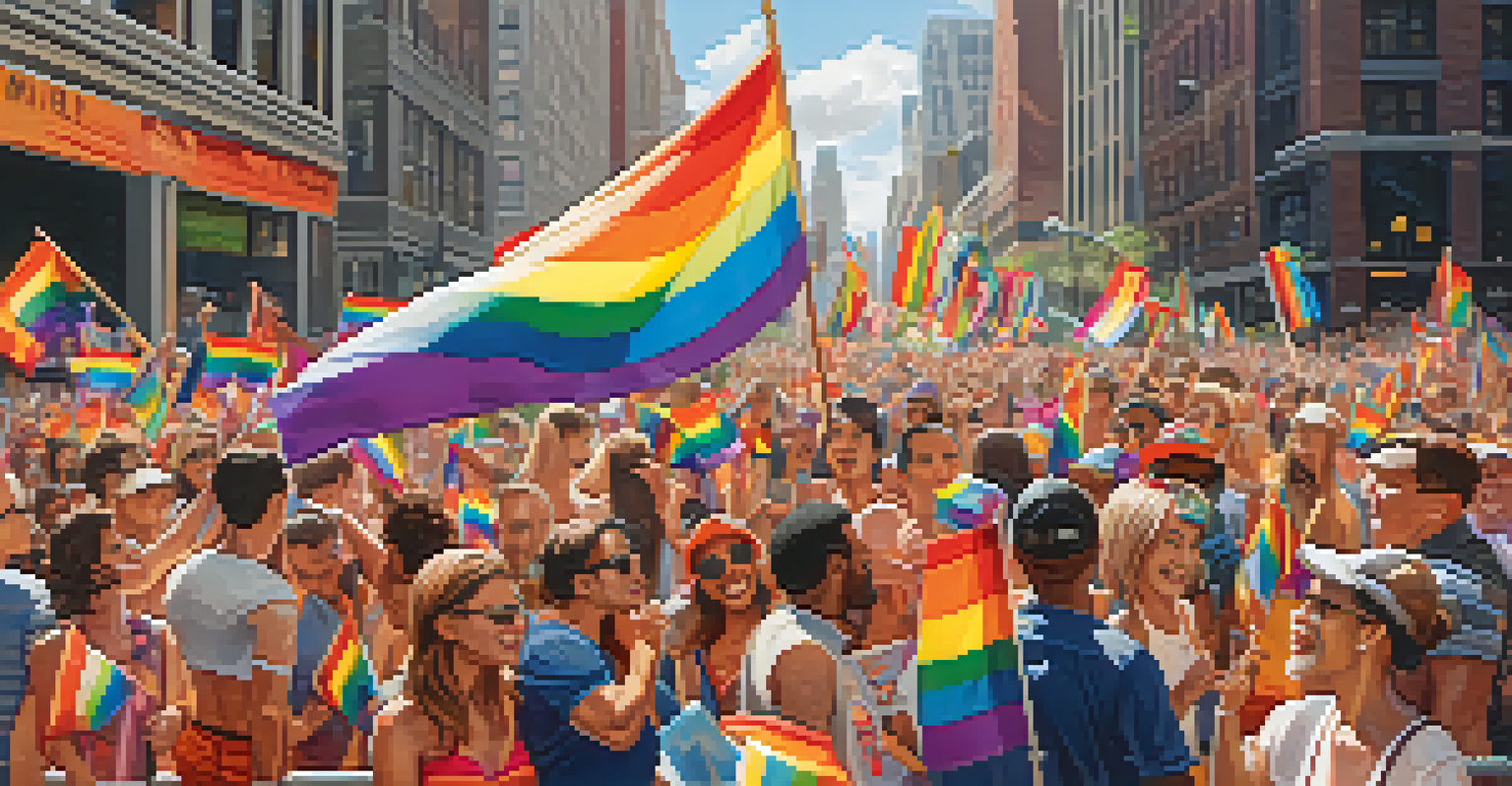The Evolution of NYC's Cultural Festivals Through the Years

The Birth of Cultural Festivals in NYC
New York City’s cultural festivals have deep roots that trace back to the late 19th century. These early celebrations often revolved around immigrant communities, showcasing their traditions and cultural pride. For instance, the San Gennaro Feast in Little Italy, which began in 1926, highlights the influence of Italian Americans and their contributions to the city.
Cultural festivals are a celebration of who we are, where we come from, and the rich tapestry of our shared experiences.
As neighborhoods blossomed with diverse populations, these festivals became a vital means of cultural exchange. They allowed different communities to share their heritage, food, and art, fostering a sense of unity in a bustling metropolis. This laid the groundwork for the vibrant festival scene that NYC is known for today.
By the mid-20th century, festivals began to gain popularity beyond local communities, attracting tourists and promoting cultural tourism. Events like the West Indian Day Parade began to emerge, celebrating Caribbean culture and drawing in crowds from all over the city and beyond.
The 1960s: A Decade of Cultural Explosion
The 1960s marked a significant turning point for cultural festivals in NYC, coinciding with the civil rights movement. This era saw the rise of multicultural celebrations that aimed to embrace diversity and promote social change. Festivals like the Harlem Cultural Festival showcased African American music, art, and culture, giving a platform to voices that had long been marginalized.

This decade also emphasized the importance of street fairs and parades as a form of expression. From the Puerto Rican Day Parade to the Greenwich Village Halloween Parade, these events became not just celebrations but also acts of political and social significance. They united communities in solidarity and pride.
Cultural Festivals: A Rich History
NYC's cultural festivals have evolved from immigrant celebrations in the late 19th century to vibrant events that highlight diversity and cultural pride.
As these festivals gained momentum, they also began to attract media attention, further amplifying their reach. What started as local gatherings began transforming into major events that drew thousands, providing exposure and opportunities for artists, musicians, and vendors alike.
The 1980s: Embracing Diversity and Inclusion
The 1980s ushered in a period of increased awareness of cultural diversity in NYC's festivals. This decade saw the rise of LGBTQ+ pride events, particularly the annual NYC Pride March, which celebrated love and acceptance while advocating for rights. The visibility of such events encouraged other marginalized communities to step forward and celebrate their identities.
Festivals are the heartbeat of a community, bringing people together to celebrate diversity and foster understanding.
Moreover, the city's growing immigrant population led to the establishment of various cultural festivals representing global heritages. Events like the Asian American Heritage Festival emerged, allowing Asian communities to showcase their traditions. This blend of cultures enriched the city’s artistic landscape.
During this time, the festivals also began to incorporate more contemporary elements like music genres, dance, and art installations, reflecting the evolving cultural dynamics of the city. As NYC became a melting pot of ideas and traditions, its festivals mirrored this vibrant tapestry.
The 1990s: Commercialization and Globalization
The 1990s brought about a new challenge for NYC's cultural festivals: commercialization. As these events gained popularity, corporate sponsorships became more prominent, altering the original community-focused essence. While this influx of funding helped expand festivals, it also raised concerns about authenticity and the dilution of cultural expressions.
Despite these challenges, the decade also saw a resurgence in grassroots movements that aimed to preserve the integrity of cultural celebrations. Artists and activists worked together to ensure that festivals remained true to their roots, emphasizing cultural education and community engagement. Events like the National Puerto Rican Day Parade continued to celebrate heritage while advocating for social causes.
Technology Transforms Festival Experience
The integration of technology in the 2000s has reshaped how attendees engage with festivals, allowing for real-time sharing and interactive experiences.
Moreover, the rise of the internet and social media began to influence how festivals were marketed and experienced. This digital shift allowed festival organizers to reach wider audiences, promoting both local talent and international acts, ultimately transforming the way New Yorkers engaged with their cultural landscape.
The 2000s: Technological Advancements and Hybrid Festivals
Entering the 2000s, technology played a pivotal role in shaping NYC's cultural festivals. With the advent of smartphones and social media, festival-goers could instantly share their experiences, creating a buzz that attracted even larger crowds. These platforms allowed for real-time updates, enhancing engagement and participation.
Additionally, the concept of hybrid festivals emerged, blending traditional practices with modern elements. Events like the Tribeca Film Festival not only showcased films but also included music, food, and interactive experiences, making them more than just passive viewing events. This shift catered to a broader audience, appealing to diverse interests.
As global issues like climate change and social justice gained prominence, many festivals began to incorporate themes of activism and awareness. They became spaces for dialogue, encouraging attendees to reflect on important societal issues while celebrating culture. This evolution highlighted the festivals’ role as catalysts for change, beyond mere entertainment.
The 2010s: Community Resilience in the Face of Challenges
The 2010s brought both challenges and opportunities for NYC's cultural festivals, particularly in the wake of events like Hurricane Sandy and the COVID-19 pandemic. These crises tested the resilience of communities, but they also highlighted the essential role of festivals in fostering connections and providing healing.
In response to these challenges, many festivals adapted by embracing technology and creating virtual experiences. Online events allowed participants to engage from the comfort of their homes, expanding accessibility and inclusivity. Festivals like the NYC Winter Lantern Festival transitioned to virtual formats, showcasing stunning displays while maintaining community spirit.
Community Resilience Through Festivals
In the face of challenges like Hurricane Sandy and COVID-19, NYC's cultural festivals adapted to maintain community connections and support local artists.
Moreover, this decade emphasized the importance of local artists and businesses. Festivals began to prioritize showcasing homegrown talent, creating economic opportunities for those directly affected by the crises. This focus on community empowerment helped revitalize neighborhoods, reinforcing the bond between culture and resilience.
The Future: What Lies Ahead for NYC's Cultural Festivals
As we look toward the future, NYC's cultural festivals are poised to continue evolving. The lessons learned from past challenges will likely inspire new formats and themes that prioritize community engagement and inclusivity. Festivals may increasingly focus on sustainability, reflecting a growing awareness of environmental impacts.
Moreover, the fusion of technology and culture will shape how festivals are organized and experienced. Augmented reality experiences, interactive installations, and global collaborations may become commonplace, offering fresh ways for participants to engage with diverse cultures. This innovation promises to keep the festival scene dynamic and relevant.

Ultimately, NYC's cultural festivals will remain a vital part of the city's identity, showcasing its rich tapestry of cultures. As new generations take the stage, we can expect a vibrant continuation of the traditions that have defined these celebrations, ensuring that they remain a source of pride, unity, and joy for years to come.